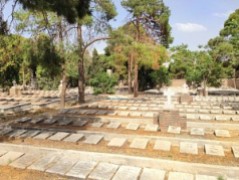Although Iran and Israel are bitter enemies, few know that Iran is home to the largest number of Jews anywhere in the Middle East outside Israel.
About 25,000 Jews live in Iran and most are determined to remain no matter what the pressures – as proud of their Iranian culture as of their Jewish roots. […]
It is dawn in the Yusufabad synagogue in Tehran and Iranian Jews bring out the Torah and read the ancient text before making their way to work. It is not a sight you would expect in a revolutionary Islamic state, but there are synagogues dotted all over Iran where Jews discreetly practise their religion.
“Because of our long history here we are tolerated,” says Jewish community leader Unees Hammami, who organised the prayers. He says the father of Iran’s revolution, Imam Khomeini, recognised Jews as a religious minority that should be protected. As a result Jews have one representative in the Iranian parliament.
“Imam Khomeini made a distinction between Jews and Zionists and he supported us,” says Mr Hammami. […]
In the Yusufabad synagogue the announcements are made in Persian – most Iranian Jews don’t really speak Hebrew well.
Jews have lived in Persia for nearly 3,000 years – the descendants of slaves from Babylon saved by Cyrus the Great. […]
It is one of only four Jewish charity hospitals worldwide and is funded with money from the Jewish diaspora – something remarkable in Iran where even local aid organisations have difficulty receiving funds from abroad for fear of being accused of being foreign agents.
Most of the patients and staff are Muslim these days, but director Ciamak Morsathegh is Jewish.
“Anti-Semitism is not an eastern phenomenon, it’s not an Islamic or Iranian phenomenon – anti-Semitism is a European phenomenon,” he says, arguing that Jews in Iran even in their worst days never suffered as much as they did in Europe. […]
In one of Tehran’s six remaining kosher butcher’s shops, everyone has relatives in Israel. […]
In between chopping up meat, butcher Hersel Gabriel tells me how he expected problems when he came back from Israel, but in fact the immigration officer didn’t say anything to him. […]
“Whatever they say abroad is lies – we are comfortable in Iran – if you’re not political and don’t bother them then they won’t bother you,” he explains. […]
His customer, middle-aged housewife Giti agrees, saying she can easily talk to her two sons in Tel Aviv on the telephone and visit them. […]
“In the last five years the government has allowed Iranian Jews to go to Israel freely, meet their families and when they come back they face no problems,” says Mr Mohtamed. […]
The exodus of Jews from Iran seems to have slowed down – the first wave was in the 1950s and the second was in the wake of the Iranian Revolution.
Those Jews who remain in Iran seem to have made a conscious decision to stay put.
“We are Iranian and we have been living in Iran for more than 3,000 years,” says the Jewish hospital director Ciamak Morsathegh.
Source: BBC News












 Read the blog and enjoy Silvia’s descriptions and pictures. Here are the links to the posts on Iran:
Read the blog and enjoy Silvia’s descriptions and pictures. Here are the links to the posts on Iran:




